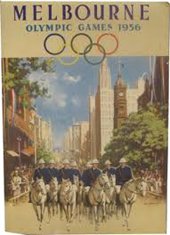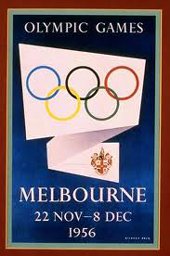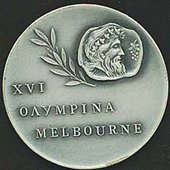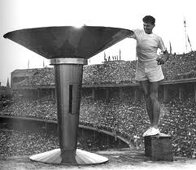1956 Summer Olympics
The 1956 Summer Olympics, the Games of the XVI Olympiad, were held in Melbourne, Australia.
They were the first Southern Hemisphere games, as well as the first to be held outside Europe, Asia or North America. They were staged in November, to make them Southern Hemisphere summer games.
Melbourne Olympic Games Facts
- 72 Nations competed;
- 3314 number of athletes, with only 376 of these women;
- 17 types of sports were represented, in 145 events;
- East and West Germany, despite the 'cold war' were competing in a combined team;
- Australia came 3rd on medal tally;
- Australians shone in swimming where they won all of the freestyle races, and collected a total of eight gold, four silver and two bronze medals;
- Dawn Fraser, Australian swimming icon, won a gold medal in the 100m freestyle, and set a new world and Olympic record;
- Australian, Murray Rose, won three gold medals in the pool;
- Australian sprinter, Betty Cuthbert, became the "Golden Girl" by winning three gold medals;
- Australian sprinter, Bobby Joe Morrow, also won three gold medals;
- Soviet gymnast Larisa Latynina, the games most successful competitor, with four gold, one silver and one bronze medal.

The stumbling blocks of the Melbourne Games
The number of athletes participating in the 1956 Summer Olympics was down by about one third compared the earlier games, because:

- The equestrian events, due to Australian quarantine regulations, were held five months earlier in Stockholm, Sweden;
- Travel to Melbourne was an expensive undertaking for many athletes, plus it required extra time required to get acclimatised;
- Northern hemisphere athletes had already competed through their summer, making this an extra long season for them;
- Egypt, Lebanon and Iraq boycotted the 1956 Summer Olympic because Egypt was invaded by Israel, the United Kingdom, and France after it had nationalized the Suez canal;
- The Netherlands, Liechtenstein, Spain and Switzerland withdrew in protest of the Soviets crushing the Hungarian Revolution;
- China pulled out, because of The Republic of Chinas (Taiwans) participation.
Remarkable Events of the 1956 Olympics
Throughout the 1956 Summer Olympics, Hungarian athletes were cheered by fans from Australia and other countries.

The match of the Hungarian water polo team against the Soviet Union became known as the Blood In The Water match. The game became rough and, when a Hungarian was forced to leave the pool with blood streaming from a cut over his eye, a riot almost broke out. But police restored order and the game was called early, with Hungary leading 4 0. The Hungarians went on to win the gold medal.
Despite the international tensions of 1956 or perhaps because of them a young Melburnian came up with a new idea for the closing ceremony. Instead of marching as teams, behind their national flags, the athletes mingled with one another as they paraded into and around the arena for a final appearance before the spectators. That began an Olympic tradition that has been followed ever since.
The Melbourne Olympics became known as "The Friendly Games".
Olympic Flame Relay
The Olympic Flame was relayed to Melbourne after being lit at Olympia on 2 November 1956:
- Greek runners took the flame to Athens;
- The flame was transferred to a miner's lamp then flown by Qantas Super Constellation aircraft "Southern Horizon" to Darwin, Northern Territory;
- A Royal Australian Air Force English Electric Canberra jet bomber flew it to Cairns, Queensland where it arrived on 9 November 1956;
- The Mayor of Cairns, Alderman W.J. Fulton, lit the first torch;
- The first runner was Con Verevis, a local man of Greek parentage
- The flame was relayed down the east coast of Australia using diecast aluminium torches weighing about 3 pounds (1.8 kg);
- The flame arrived in Melbourne on 22 November 1956;
- The Olympic Flame was lit at the stadium by Ron Clarke.

Do you like this page? Why not pay it forward with a Facebook 'Like' or Google
Follow us on Facebook, via our Newsletter, Blog or Twitter:
Like this site?
If you wish to receive our facebook updates, you will need to 'like' our Facebook page directly. Click here






 WLM on Facebook
WLM on Facebook INSIDERS News
INSIDERS News The WLM Blog
The WLM Blog Melbourne Twitter
Melbourne Twitter
New! Comments
Have your say about this! Leave us a comment in the box below.